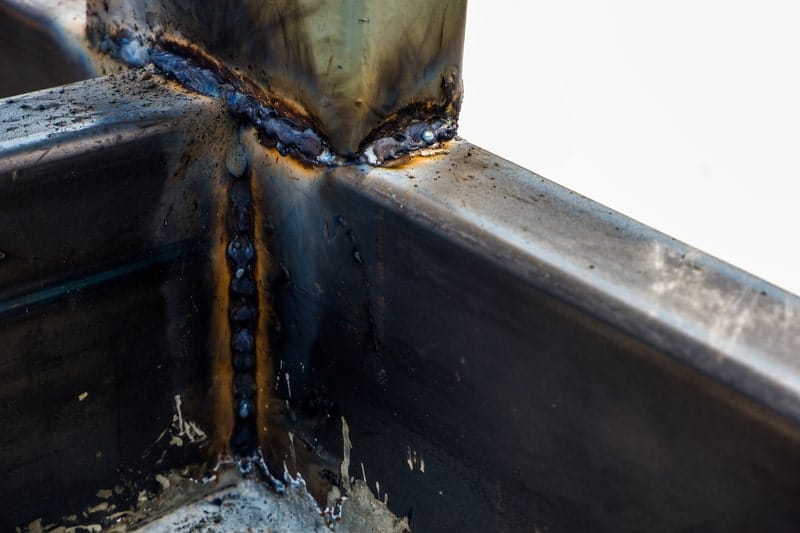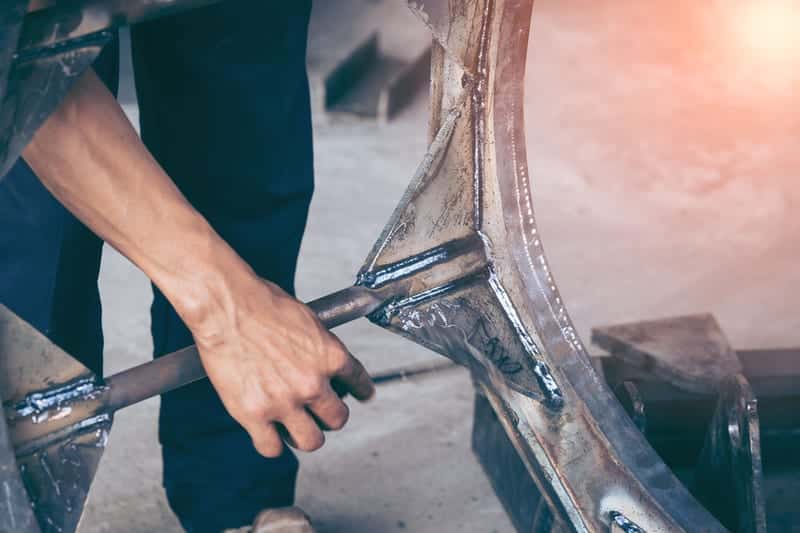“This post contains affiliate links, and I will be compensated if you make a purchase after clicking on my links.”
As I was looking for more affordable options to stick weld dual-material joints with stainless steel, I came across this question. This article will bundle my research for you.
You can stick weld stainless steel to mild steel. It is essential to use the correct electrode. Ideally, using an E309 welding electrode. However, E308 or E310 electrodes also work. While E308 and E310 are generally cheaper, joint quality will be higher with E309 or E309L welding rods.
While that was the short answer, I have added some details and pieces of knowledge to help you create successful stainless steel to mild steel joint with stick welding. If you are new to welding, there are some helpful insights at the end to answer some questions that might arise.
How to stick weld stainless steel with mild steel
While welding stainless steel to a dissimilar metal like mild steel changes nothing on the stick welding process or welder setup compared to joining similar materials, the most crucial factor for a successful joint is the electrode choice.
How to choose the right electrode
Below you find an overview table with the best rods to use for the application. My recommendation would be the E309 or E309L. The “L” refers to the alloy composition, which has a higher content of Carbon. Carbon increases the resistance against intergranular corrosion.
As you can see in the overview, the E309 electrode is a bit more pricey. If you intend to weld more volume, this might be the right choice for you. For beginners or small-batch welding, going with the higher quality rod is probably the better option.
| Electrode | Typical Application | Price per lb |
| E308 | Versatile electrode designed to weld several types of austenitic steels. | 6-8$ |
| E309 | Rutile-basic coated, high-alloy stick electrode. Designed for joining stainless steel to mild or low alloy steel. | 8-10$ |
| E310 | Most frequently used to weld base metals of similar composition. Conforms to AWS A5.4 | 6-8$ |
Which rod diameter shall I choose?
Rod diameter depends on the thickness of the material that you would like to join. Generally speaking, though, going with some commonly available diameters will make your welding project more affordable since you can reuse the electrodes for other projects. Electrodes, once open, have a shelf live. Even though they won’t go off, they might need drying in an oven to remove the excess water content.
The water-soaked out of the atmosphere into the flux will lead to porosity and hydrogen inclusions in the weld. Additionally, it makes the electrodes challenging to weld with or even ignite. Make sure to follow the manufacturer’s recommendations that come with the package to get the most out of your electrodes.
What are standard diameters? 1/8″ or 3/32″ are suitable diameters to have in stock. Both diameters are easy to source for stainless steel rods. Keep in mind that ultimately, you can weld all material thicknesses with all rod diameters; choosing a different diameter affects your welder settings (which affects heat input) and weld speed (which affects weld volume per time). Therefore pick the electrode that is easier to access for you before you lose yourself in optimization details.
How to weld?
Welding dissimilar materials follow the same best practice rules that are true for similar material welding. Here are some key points to look out for:
- Make sure all surfaces are cleaned. Stick welding is much more forgiving than other welding processes; however, inclusions and impurities are often caused by dirty surfaces.
- In the case of mild steel, grinding the dark protective layer is optional for stick welding. The layer evaporates during the welding process and does not harm the weld bead.
- Prepare a chamfer on the edges of the material where both pieces join. The chamfer will allow the weld to flow in and leaves a flusher result. Also, having a shiny surface always helps the arc.
- Pro Tip: Have a scrap piece of metal at the edge of your joint to ignite the arc. This will help create a cleaner-looking weld with enough volume and flow at the start of the weld bead.
Commonly asked questions for stick welding stainless steel to mild steel.
What is mild steel?
Mild steel is commonly used as structural steel, wire & fencing, decoration & artworks, or furniture. Also, most common nails are made out of mild steel. Another term for mild steel is low carbon steel, which refers to the alloy composite.
A low carbon content, generally speaking, makes it easier to weld. A property that benefits from a low carbon content is ductility (e.g., signposts would be made out of mild steel). The trade-off is a decrease in strength and hardness of the steel compared to higher carbon content steel. Also, while mild steel is better machinable and foremost weldable, it is next to impossible to harden or strengthen.
Another important property of mild steel is that apart from the main ingredients, iron, and Carbon, not many other alloy elements are contained in the steel.
How to spot mild steel?

These would be my recommended steps to be sure you have mild steel:
- Datasheet or marking: Look into the markings on the material or data sheets that came with the material. Good chance you can’t find both. However, this would be my obvious first step.
- Find a magnet: As mild steel is > 99% iron, it is also magnetic.
- Optical check: To protect mild steel from oxidation, it has a black protective coating. Also, spotting rust can be a hint that you have mild and not stainless steel.
- Hardness and tensile strength test: Using additional analytic equipment is probably the most impractical step, especially for small jobs. However, it is an honorable mention.
What is stainless steel?
The main property of stainless steel is its corrosion resistance. Compared to mild steel, this is achieved by alloy elements that are added to the steel, mainly chromium. Don’t be fooled by the term “corrosion resistance,” though. This term refers to the important fact that stainless steel can only resist corrosion while still be able to rust.
Rusting of stainless steel occurs when the protective chromium layer gets damaged. This layer protects the main element of stainless steel, iron, from direct contact with oxygen. Once this armor is pierced, stainless steel can rust as well. One can observe this, for example, in the kitchen or other stainless steel appliances that have some deeper scratches and are exposed to water. These scratches have damaged the protective layer while not allowing enough chromium to bind with oxygen to protecting chromium oxide. Therefore allowing rust.
Applications for stainless steel are everywhere where high standards in cleanliness have to be kept, for example, kitchens, pharmaceutical or food production, and aerospace.
How to spot stainless steel?
To find out if you have stainless steel in front of you, my recommendation would be to go through the following steps:
- Datasheet or marking: Sometimes, the paperwork for the material is still around. Otherwise, check for markings or codes on the material. Every steel has a code to tell you the exact composition and metal group.
- Get the magnet: Stainless steel is not magnetic! The magnetism is due to the metallurgy of the steel. Austenitic steels are usually not magnetic. (If you would like to learn more about how metallurgy affects your weld material, check my article here).
- Optic and Weight check: Stainless steel has a density of 7.9 g/cm3, while Aluminum has a density of less than a third of that (2,70 g / cm3). So if your material looks shiny silver and is significantly lighter than the mild steel you are trying to join, chances are you have Aluminum in your hand.
- Hardness and tensile strength measurement: While this needs professional equipment, if you have access to these tools and are still unsure, this will help you pinpoint your material without more elaborate lab testing.
These are my key points for tackling a dissimilar stick welding project like joining stainless steel with mild steel. Best of luck with your project!
Sources
What Is Mild Steel? | Metal Supermarkets (metalsupermarkets.com)
Difference Between Stainless Steel and Galvanized Steel | Metal Supermarkets (metalsupermarkets.com)




